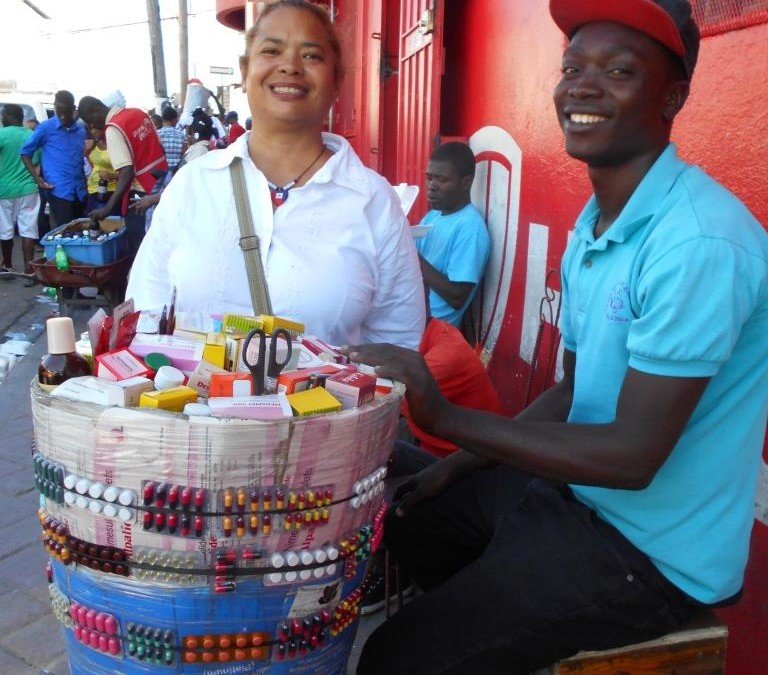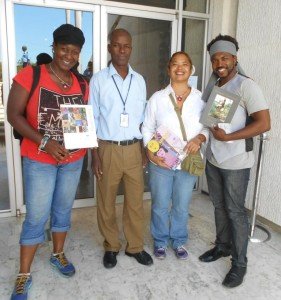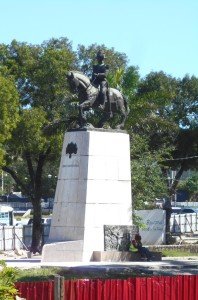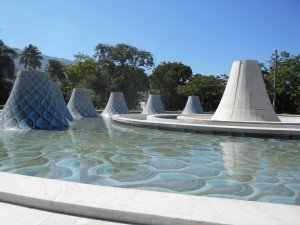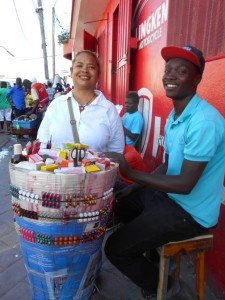This morning we caught a minibus and went to Port au Prince to visit the Musée du Panthéon National Haitien and the National Museum of Art. We managed just the former, but saw great art anyway.
Andrea and I sat in front with the driver, and enjoyed passing views of streets, vendors, vehicles through a cracked windscreen artfully accessorised with bullet-hole stickons. This bus was packed with 18 passengers in back of us, and as the bus had no door, Prensnelo, who sat just behind us, hung onto the back of our seat… for dear life. All in all there were 20 of us plus the driver whizzing through the traffic, horns blaring left and right, on the way downtown. The drive was en par with the St George’s to Grand Anse bus route around 430pm. The driver detoured twice onto side roads, more to avoid the traffic than to avoid police officers who suddenly appeared in the middle of the main streets. The highlight of the journey was the second detour near to a polyclinic. Our driver put his hand on the horn – a screeching high pitch of a horn – and kept it there, regaling a driver of a van who could not, would not shift his vehicle a foot to the right, so an SUV behind him could pass, so then our bus could continue onwards. Well, once the driver began his chastising, voices from behind me in the bus chimed in. Pedestrians and road workers in fluorescent jackets also threw in their gourdes (I’m in Haiti… not cents, gourdes), and the poor van driver had little choice but to shift his carcass and let us all pass.
The rest of the journey was anticlimactic, and we got off next to a slew of souvenir vendors, who pointed us in the right direction to the museum. There were several areas fenced off with brightly coloured galvanise indicative of ongoing construction, so it was easy to become confused, what with the addition of blaring horns, black exhaust smoke and garbage stretching from road to sidewalk, neatly sidestepped by walkers on cellphones.
The museum is across from a similarly fenced area over which the statue of Henri Christophe towers. Just to recap… Christophe, first King of Haiti was born in Grenada in 1767 on Sans Souci Estate in Saint Andrew. Ceramic cones in shades of blues from turquoise to cobalt, sitting in a semicircular pond comprise the museum’s roof, and the entrance is at the end of a wide flight of steps. Descending them I felt like I was entering an Egyptian tomb. The inside of the museum is simple, and simply stunning. Information and artifacts cover the history of Haiti from the Amerindians, to treatment of the Indians by the Spaniards and the treatment of African slaves by the French, to Papa Doc Duvalier. There is a wall with images of the emperors/kings/presidents of Haiti, bronze sculptures, and display stands with swords, personal jewellery, medals and letters.
The items I was interested in pertained to Christophe, and it gave me a momentary upset to see the silvered pistol with which Christophe committed suicide in 1820. Once the museum staff realised that Andrea and I were from Grenada—and they knew full well the connections, since it is recorded in Christophe’s timeline next to the pistol—they were extremely gracious to us. No cameras (or guns, according to the notice on the door) are allowed inside the museum, but we were told to come back and maybe something could be worked out.
This site http://mangodhaiti.blogspot.com/2012/12/haiti-tourism-inc-photos-musee-du.html has good images of the interior.
I did not think that anything could trump Christophe’s artifacts, but there was. We came on a very good day, when scores of school children from kindergarten to teenagers were being taken on tours by the museum staff. It was heartening to hear the history of Haiti being told to them, see the interest on their faces and then hear the students repeat the important facts. Armed with their history, these students surely know where they, and Haiti, come from. Hmm, in Grenada, our students should be so fortunate.
The museum is structured so that after viewing the historical bits, visitors are ushered into the art gallery where there is an exhibition of Haitian art, about 30 paintings in various techniques, spanning several years. As cameras (or guns) were not allowed, I lingered as long as I dared, trying to commit as many as possible to memory. Dukernst Biamby, conservation painter and one of the curators, gifted us a catalogue of that show. I’ll scan a few pages for a future post.
The bus drive back to Petion Ville was just as noisy, somewhat dusty, but not as exciting. We dropped off on the corner before the hotel, and, as before, stepped right into a slew of vendors. This time the wares offered for sale were medicines. The pharmacist in my blood surfaced, and I went poking around in his ‘shop,’ discovering 4 types of antibiotics, and at least as many cough and cold remedies, sleeping aids and pain relievers neatly packed in between unguents, lozenges and condoms. The majority of the offerings were from a pharmaceutical house in India. He was not the first I saw on this trip; others drouged pharmaceutical monuments up to 6 feet tall and good 20 inches across. I wondered how the handful of bricks and mortar pharmacies could stay in business if these mobile drugstores were plying their trade on the sidewalks.
They probably manage somehow, and as my brother often says, ‘everyone has to eat a food.’ In a country of 12 million souls, there are many, many mouths to feed.
Tomorrow, I’ll go look for the National Museum of Art or maybe just visit some nearby galleries. With art camp beginning in 2 days, I need to have Haiti under my skin to be able to fully benefit from this experience.

